 |
 |
 |
| |
Antiretroviral Therapy Does Not Dial Back Advanced Epigenetic Age With HIV
|
| |
| |
8th International Workshop on HIV and Aging, October 2-3, 2017, New York
Mark Mascolini
Antiretroviral therapy (ART) did not erase the older epigenetic age associated with untreated HIV infection in a longitudinal comparison of HIV-positive and negative men in the Multicenter AIDS Cohort Study (MACS) [1]. Researchers from the University of California, Los Angeles (UCLA) also found evidence that highly differentiated CD8 cells provide a marker of overall biological age and predict increased morbidity and mortality.
Epigenetics involves "alteration of DNA through modifications that do not change the underlying nucleotide sequence, yet are important in controlling gene expression" [2]. The many types of epigenetic regulation include methylation of cytosine residues. Epigenetic clock-crafter Steve Horvath believes that "DNA methylation age measures the cumulative effect of an epigenetic maintenance system" [3].
Prior research by the UCLA team found that methylation patterns in antiretroviral-naive adults indicate that their epigenetic age exceeds their chronological age by 14 years [2]. That finding suggests HIV speeds up at least this aging mechanism. Because antiretroviral-treated people run an increased risk of age-related diseases, these investigators hypothesized that "ART initiation does not restore HIV-perturbed epigenetic patterns to age-appropriate levels, and that DNA methylation ages stay advanced in treated HIV-infected adults compared to chronologically age-matched controls."
To test those hypotheses, the UCLA researchers compared methylation patterns in lymphocyte subsets of 15 HIV-positive antiretroviral-treated men (all with an undetectable viral load) and 15 HIV-negative men in the MACS, an ongoing observational study of men who have sex with men (MSM). They collected frozen peripheral blood mononuclear cell (PBMC) samples from HIV-positive men 1 year before and 1 and 2 years after they started ART. Control PBMC samples came from HIV-negative men matched to the HIV group by chronological age and study visit.
The UCLA team used Horvath's epigenetic clock [3] to compare DNA methylation patterns in these PBMC sets. They used weighted gene comethylation network analysis (WGCNA) to spot changes in methylation patterns linked to ART initiation. And they used standard flow cytometry to measure lymphocyte subsets.
According to the epigenetic clock, men with untreated HIV infection had a DNA methylation age about 8 years older than their chronological age (P = 0.00062). When these men started ART, treatment did not restore an age-appropriate DNA methylation age. After 2 years of ART, about 6 years still separated epigenetic age from chronological age (P = 0.017).
Before they began ART, men with HIV had higher levels of total, senescent, terminally differentiated, and activated CD8 cells than HIV-negative men. These CD8-cell subsets were significantly associated with DNA methylation age. Even after 1 and 2 years of ART, all four CD8-cell subsets remained elevated compared to the HIV-negative group, and all remained significantly associated with DNA methylation age. WGCNA analysis could not link any gene network consistently to ART, a finding indicating that ART "did not have a strong global impact on HIV-induced age-accelerated epigenetics."
The UCLA investigators believe their findings support previous research nominating highly differentiated CD8 cells as a marker of overall biological age and a predictor of increased morbidity and mortality with HIV. Together with the finding that ART does not restore age-appropriate DNA methylation patterns after 2 years of treatment, these results "suggest that HIV-induced age acceleration, partially mediated through epigenetic changes, may be directly associated with the earlier functional and clinical decline observed in virally suppressed HIV-infected adults on ART." The researchers plan to continue these analyses in larger numbers of MACS men. They hope this research will eventually uncover targets for therapeutic intervention.
References
1. Rickabaugh T, Sehl M, Shih R, et al. Inability of ART to restore age-appropriate epigenetic patterns in HIV-infected adults. 8th International Workshop on HIV and Aging. October 2-3, 2017. New York. Abstract 1.
2. Rickabaugh TM, Baxter RM, Sehl M, et al. Acceleration of age-associated methylation patterns in HIV-1-infected adults. PLoS One. 2015;10:e0119201. http://journals.plos.org/plosone/article?id=10.1371/journal.pone.0119201
3. Horvath S. DNA methylation age of human tissues and cell types. Genome Biol. 2013;14:R115. https://genomebiology.biomedcentral.com/articles/10.1186/gb-2013-14-10-r115
--------------------------
Inability of ART to Restore Age-Appropriate Epigenetic Patterns in HIV-Infected Adults
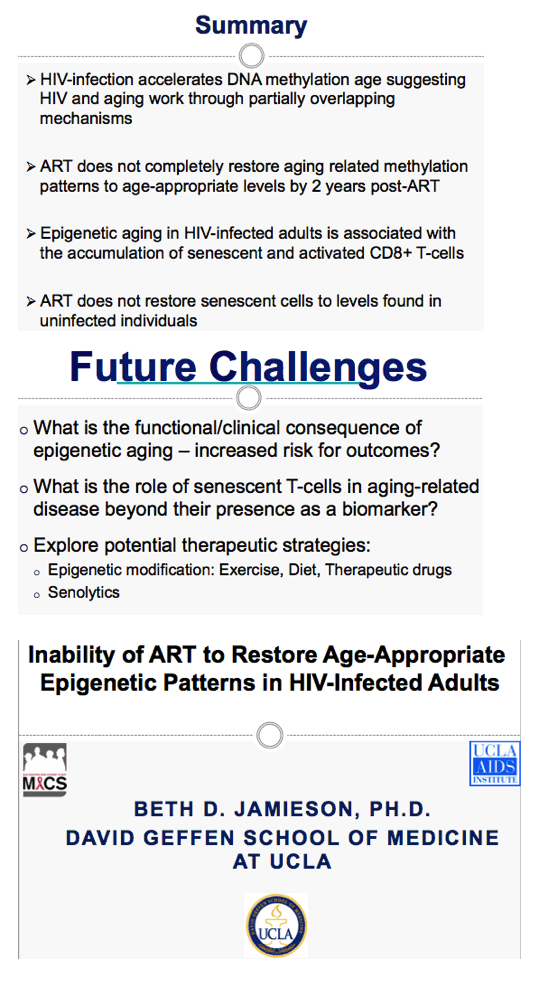
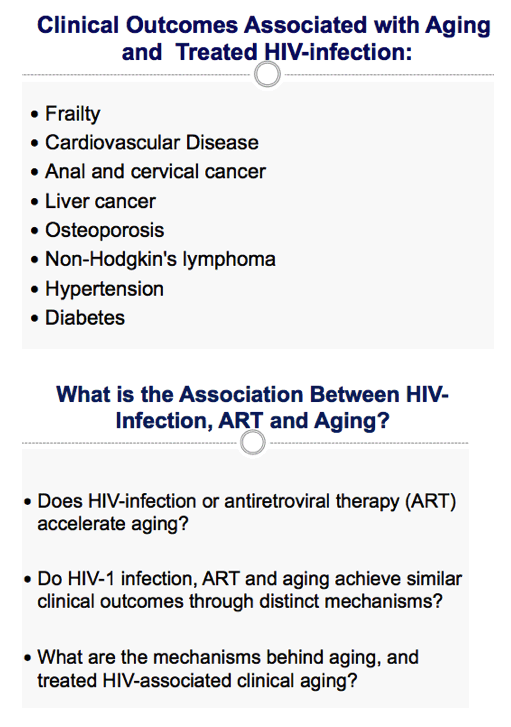
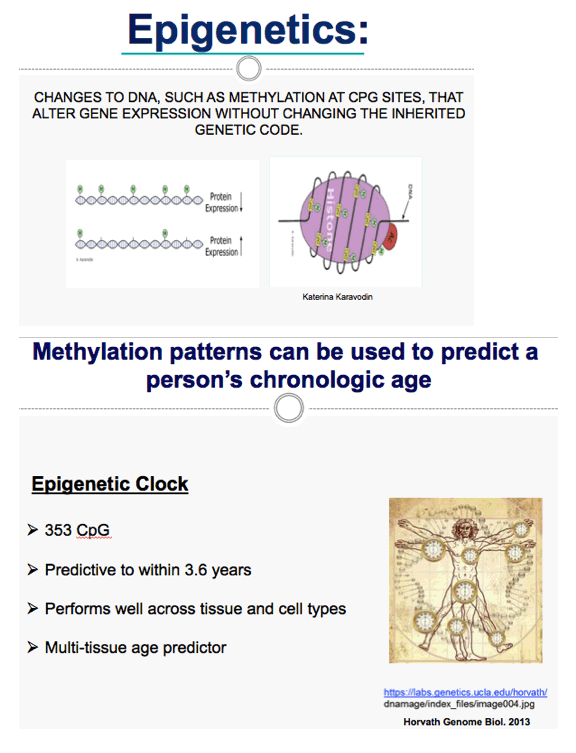
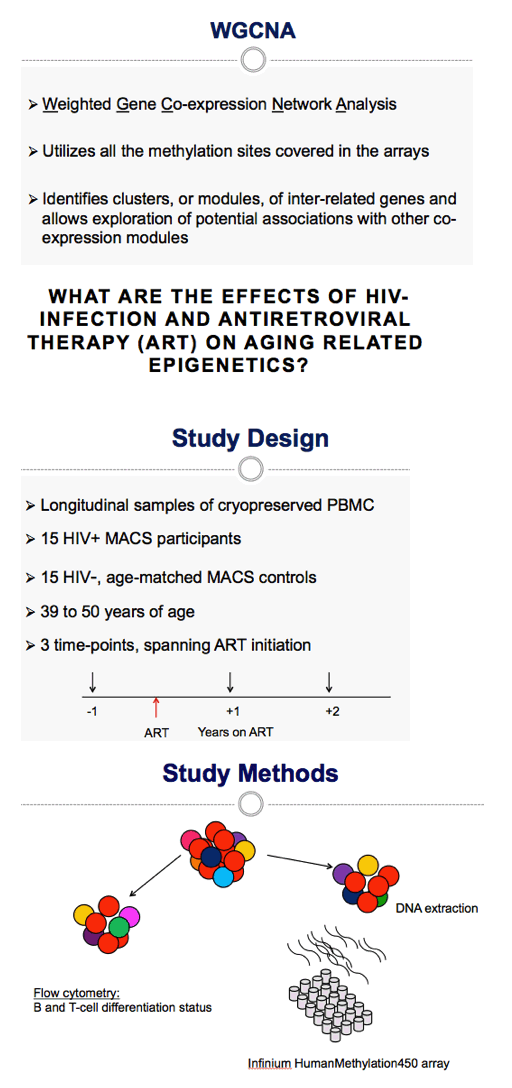
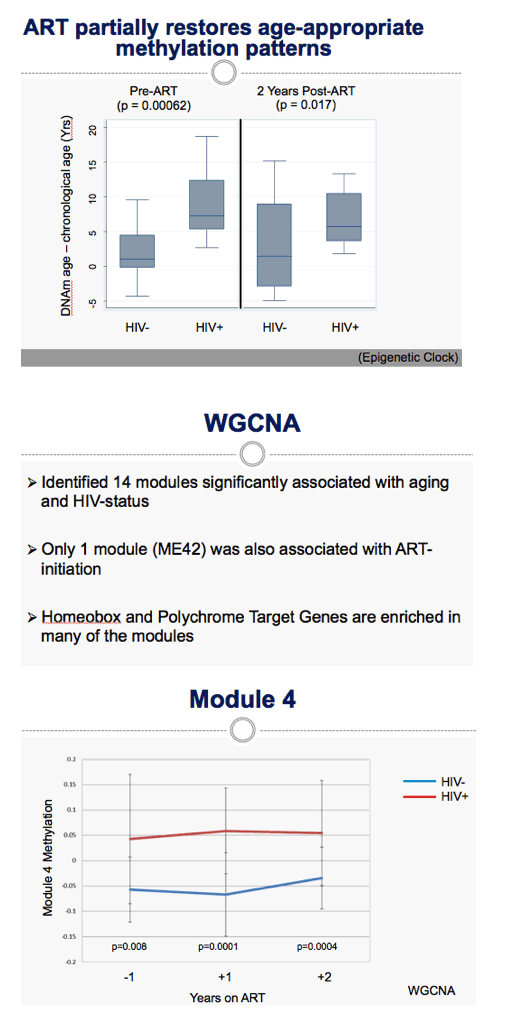
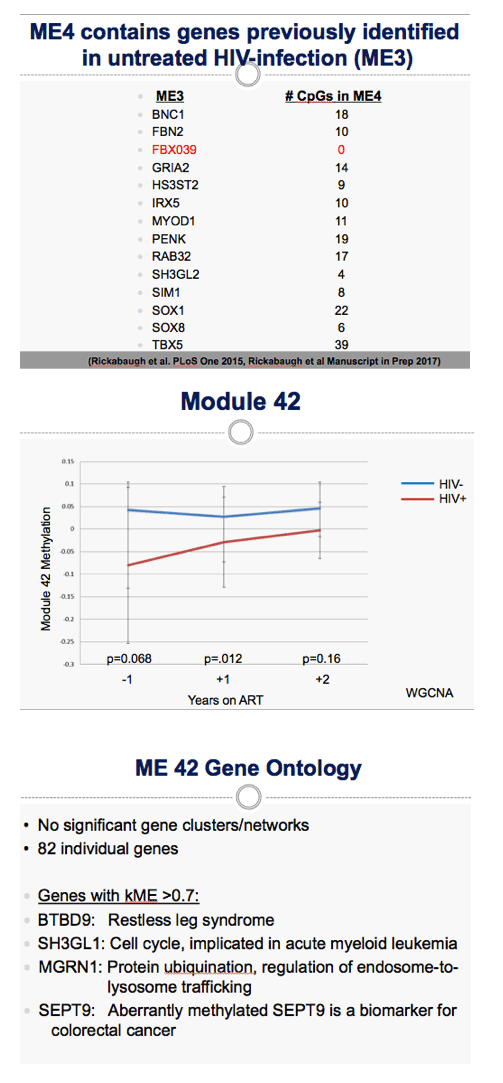
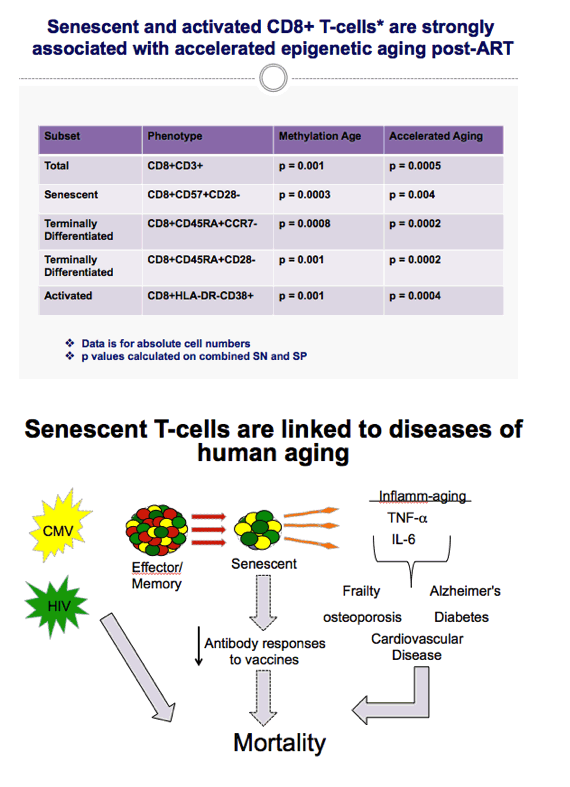
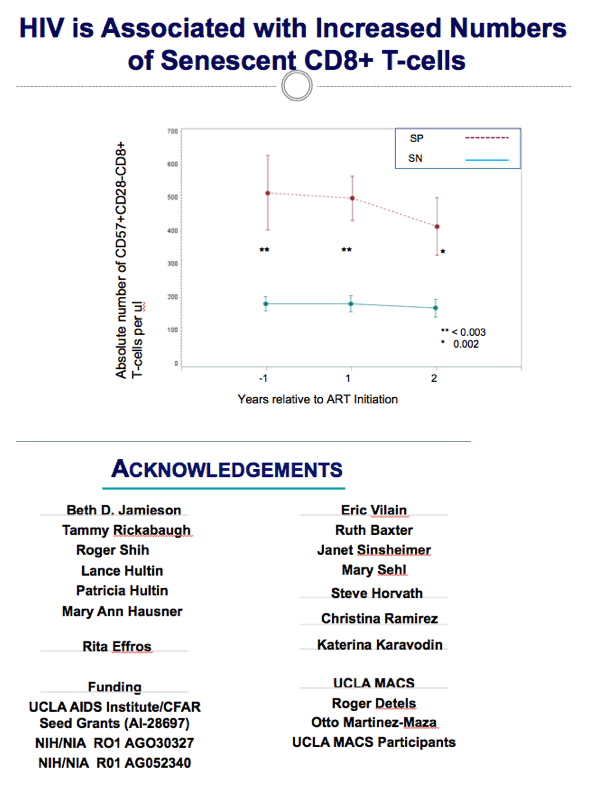
ABSTRACT
Inability of ART to Restore Age-Appropriate Epigenetic Patterns in HIV-Infected Adults
Dr. Tammy Rickabaugh1, Dr. Mary Sehl1, Mr Roger Shih1, Dr. Oto Martinez-Maza1, Dr. Steve Horvath1, Dr. Christina Ramirez2, Dr. Beth Jamieson1
1David Geffen School Of Medicine At Ucla, Los Angeles, United States, 2Fielding School of Public Health at UCLA, Los Angeles, United States
Background: Life expectancies of HIV-infected adults on antiretroviral therapy (ART) are similar to those of their uninfected peers, but treated individuals appear to be at increased risk for the earlier development of some aging related diseases such as osteopenia, frailty, and neurologic dysfunction, and an early decline in gait speed and grip strength. We previously documented that untreated HIV-infected adults have DNA methylation patterns that predict their epigenetic age to be 14 years older than their chronologic age, suggesting that HIV-infection accelerates at least some of the underlying mechanisms of aging (Rickabaugh et al. PLoSOne 2015). However, as it is HIV-infected adults on ART who are at increased risk for clinical and functional outcomes of aging, we hypothesized that ART initiation does not restore HIV-perturbed epigenetic patterns to age-appropriate levels, and that DNA methylation ages stay advanced in treated HIV-infected adults compared to chronologically age matched-controls.
Material & Methods: To perform a longitudinal analysis of methylation status and lymphocyte subsets in HIV-infected men who initiate ART, we obtained cryopreserved PBMC from men (N = 15) enrolled in the Multicenter AIDS Cohort Study (MACS) one year prior to, and one and two years post-, ART initiation. Samples from uninfected MACS men served as age-matched ethnic and visit matched controls (N = 15). DNA methylation (DNAm) age was calculated using Steve Horvath's Epigenetic Clock. Weighted gene co-methylation network analysis (WGCNA) was used to identify changes in global methylation patterns associated with the initiation of ART, and to evaluate whether HIV-associated global methylation changes are affected by ART. Lymphocyte subsets were quantified by flow cytometry.
Results: Epigenetic Clock analysis revealed that untreated HIV-infection was associated with an accelerated DNAm age of ~8 years (p = 0.00062). Untreated HIV-infection was also associated with an increase in total, senescent, terminally differentiated, and activated CD8+ T-cells and those subsets were significantly associated with DNAm. ART was unable to restore DNAm age to age-appropriate levels (p = 0.017) and all four CD8+ T-cell subsets remained elevated and significantly associated with DNAm age. WGCNA analysis revealed 14 modules significantly associated with HIV-status, but only 1 of the 14 modules also demonstrated a trend towards an association with ART. However, no consistent network of genes was significantly associated with ART, demonstrating that ART did not have a strong global impact on HIV-induced age accelerated epigenetics.
Conclusions: These findings support numerous studies which suggest that an accumulation of highly differentiated CD8+ T-cells is a biomarker of overall biological age and a predictor of increased morbidities and mortality. Our results also demonstrate that ART does not restore DNA methylation to age-appropriate patterns. Together, these data suggest that HIV-induced age-acceleration, partially mediated through epigenetic changes, may be directly associated with the earlier functional and clinical decline observed in virally suppressed HIV-infected adults on ART. These results will allow us to explore potential epigenetic changes that may serve as biomarkers for functional and clinical outcomes in both HIV-infected and uninfected adults, and may reveal potential targets for therapeutic intervention.
|
| |
|
 |
 |
|
|